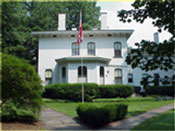| 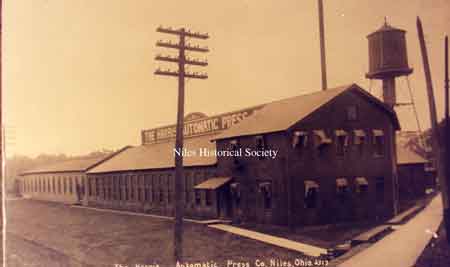
PO1.546
Photo of the Harris Automatic Press Co. located
in Niles for many years. Constructed about 1904 and operated until
1914, after a prolonged strike moved operations to Cleveland.
The building was used as a soup kitchen during the Great Depression
and dismantled shortly thereafter.
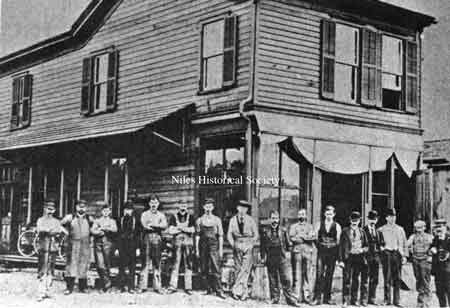
PO1.550
|
Twelve
Important Industries Located in Niles During the Decade From 1902
- 1912. (From
Centennial Club History)
Scarcely a Year Passed in This Period With-out
A New Plant.
After 1900, scarcely a year passed without addition of one or
more industries.
Harris Automatic Press
Company
Initial success was obtained when the Harris Automatic Press Company,
offered a bonus of $1500 and a free site, removes to Niles, occupying
the space just north of the Erie railroad tracks on the west side
of North Main Street. Later, in 1914, the company removed and
the Hubbard Pressed Steel Company occupied that site.
The employees of the Harris Automatic Press Co.
around the turn of the previous century. Charles and
Alfred Harris are the fourth and fifth gentlemen from the
right. The house in the picture was the boyhood home of William
McKinley; later it served as the Harris Company's first plant.
The house stood on the site of the reconstruction of McKinley's
home, and the Old Main Ale & Chowder House.
|
|
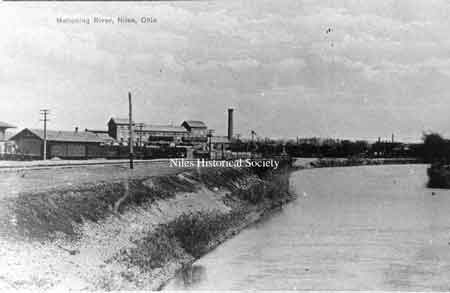
PO1.562
The Niles Firebrick Co. was constructed by John
R. Thomas in 1872 and was one of Niles' most enduring industries.
It was known nationwide for its high quality firebrick. The new
type of blast furnaces introduced after WWII made firebrick obsolete
and the plant closed and was dismantled in 1974-75. |
Fire
Brick Reorganized
Also in 1914, the Niles Fire Brick reorganized with a capital
of $60,000. The No. 1 Plant, built in 1872 by John R. Thomas,
had been moved from its original site near the Mahoning River
in 1882. It now stands south of the Erie railroad opposite the
passenger station.
In 1905 the No. 2 brick plant was erected on
the original site of the No. 1 plant; in 1910 this plant was enlarged
for the manufacture of Silica brick. The No.2 plant works is a
modern plant. P.J. Sheehan, present general manager,
has been associated with this firm since 1881.
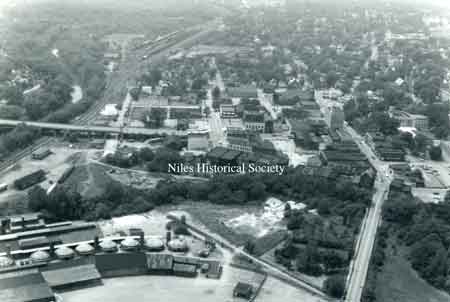
Larger overview from NE corner of city with Niles
Firebrick kilns lower left. PO1.854
|
|
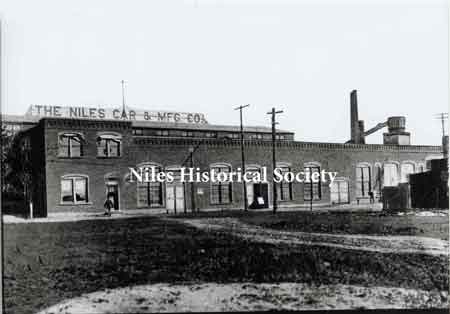
PO1.1434
Erie Street view of the Niles Car
and Manufacturing Company, makers of one of the finest lines of
plush electric cars of the area. This building was located on
the block bounded by Erie, South Cedar, Allison Avenue and Mason
Street and operated for 16 years before being converted to truck
chassis.
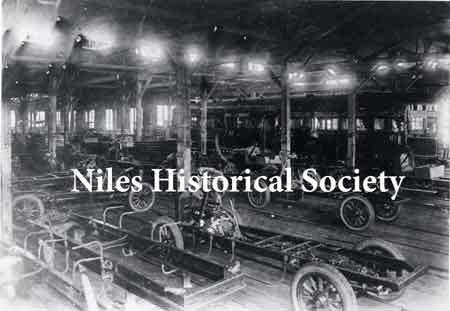
PO1.1454
Inside the Niles Car and Manufacturing Co. about
1915 when the streetcars were being phased out and truck chassis
were being built.
Note the Nashville, Chatanooga & St. Louis
interurban car in the background. |
Niles
Car and Manufacturing Company.
The rapid expansion of the electric street railways about that
time led local men, headed by Frank Robbins, to organize
in 1901 the Niles Car and Manufacturing Company. A large plant
was erected covering a block between Erie and South Cedar streets.
For a dozen years, when street railways were the only convenient
means of interurban travel, this firm prospered.
Subsequently “Niles” trucks were
manufactured there; during the war the Engel Aircraft Corporation
manufactured airplane bodies for the government and in 1919 the
American Tire Corporation incorporated and used the plant for
a few years. It is now occupied by the Stevens Metal Products
Company.
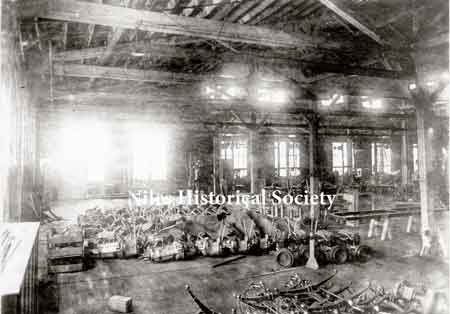 Inside the Niles Car & Manufacturing
Co. about the time that conversion to truck bodies began.
Inside the Niles Car & Manufacturing
Co. about the time that conversion to truck bodies began.
PO1.1529
A steel, center-door car built in 1915 by the
Niles Car and Mfg. Company for the Cleveland and Erie Railway.
#207 was one of the first lightweight interurbans built by the
Niles Car Works and was one of the last group of cars this company
built. PO1. 1579
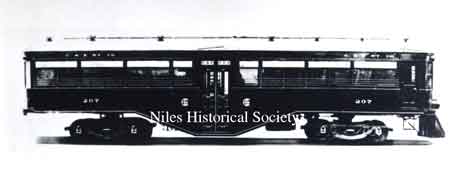
|
|
|
| 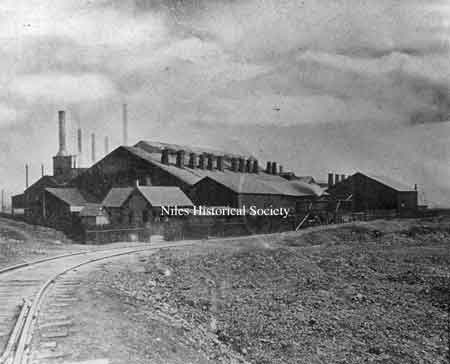
PO1.503
|
Niles
Sheet Iron Company.
In 1902, the Board of Trade was influential in bringing two very
important concerns to Niles. The offer of $10,000 and a free site
induced W. A. Thomas, James Patterson and associates
to construct a sheet mill on the north bank of the Mahoning River
just west of the viaduct leading to McDonald. The newspapers of
the time refer to it as the Niles Sheet Iron Company and describe
how a small steamboat was used to carry workmen between the South
Main Street bridge and the mill.
American Sheet & Tin Plate Co., made first
tinplate in the US. Constructed in 1891 by Falcon Iron & Nail
Co., originally the James Ward Company but acquired by the Arms
Brothers and John Stambaugh after the 1873 Ward
failures. |
|
|
|
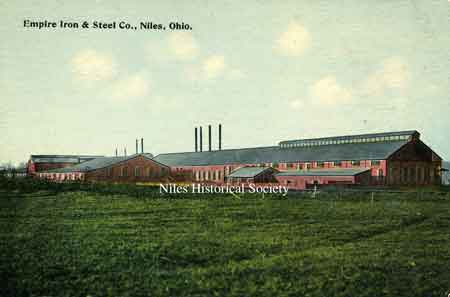
Two different views of the Empire Iron &
Steel Company. PO1.516
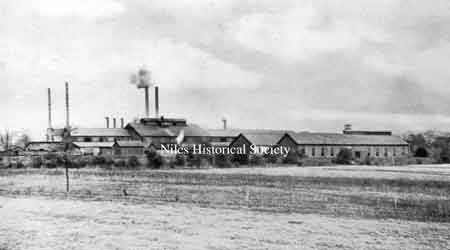
PO1.515
|
Empire
Iron and Steel Company
About the same year, 1902, by the offer of a bonus of $13,333,
the Board of Trade persuaded Wade A. Taylor, C. S. Thomas
and John O’Dea to build in Niles a rolling
mill called the Empire Iron and Steel Company. This plant was
erected on the south bank of the Lisbon branch of the Erie Railroad.
The plant was sold to
Jonathan Warner & Assoc. in 1905. In approximately
1912, it was sold to Brier Hill Steel Company which merged with
Youngstown Sheet & Tube Company.
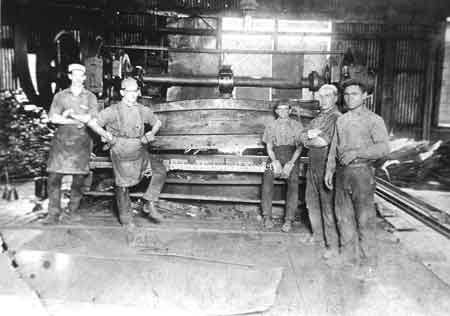 Picture
of the old squaring shears at the Empire Mill. Dated 1909. Picture
of the old squaring shears at the Empire Mill. Dated 1909.
PO1.517
|
|
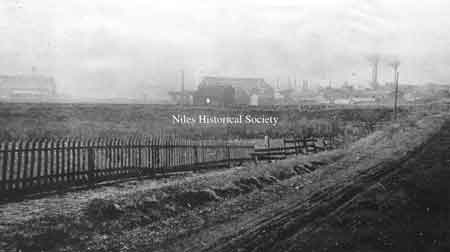
PO1.519
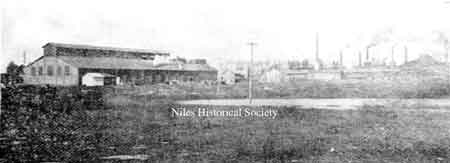
PO1.521
Smoky industrial skyline of Niles
at the peak of iron manufacturing, descibed by historian Howe
in 1888 as "among the most extensive in the state."
All structures were part of Ward
Enterprises, however by 1900 they had all been demolished. This
photo is captioned Falcon Iron & Nail Co.'s Mills. Galvanizing
works and Coleman Shields Co. Mills, Niles, Ohio.
|
In 1902, F. F. Bentley, A.J.
Bentley and A.J. Leitch erected the Ohio Galvanizing
and Manufacturing Company plant at the foot of Ann Street.
This plant is still in active
operation with C.B. Robinson now president and W.R.
Robinson, vice president and treasurer.
PO1.1087
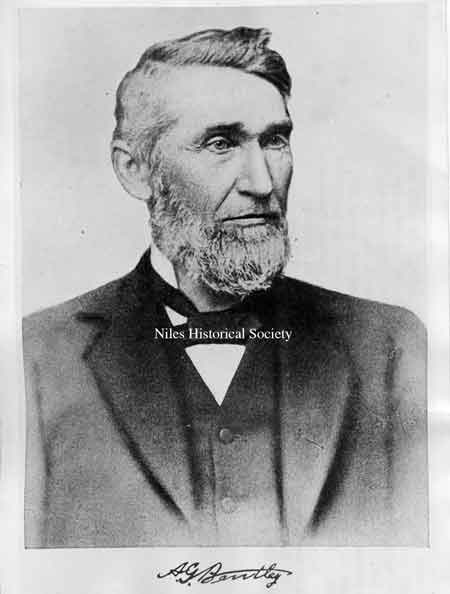
A.J. Bentley PO1.1087
|
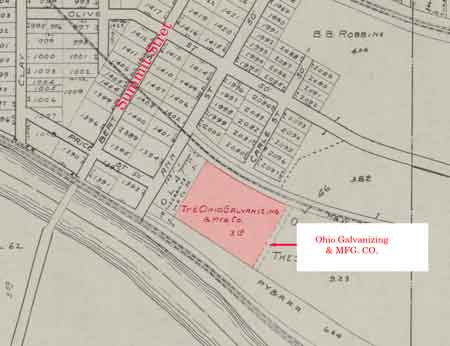
Location of Ohio Galvanizing Company on 1918
map.
Ohio Galvanizing and
Manufacturing company.
The improvement that came with these industries caused officials
of one company to complain of the housing shortage faced by their
employees. Other industrial accessions followed. |
|
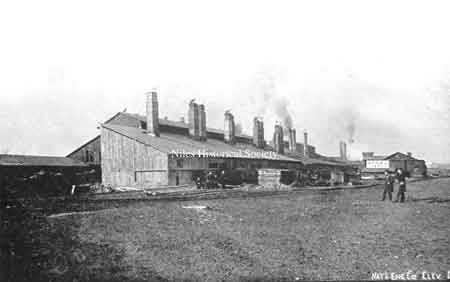
PO1.621
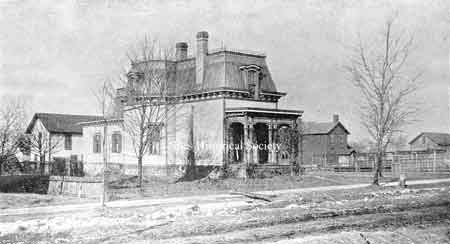
PO1.448
|
R.G.
Sykes Metal Lath Company.
In 1903 the Sykes Metal Lath Company was located on Walnut Street.
After operating for more than twenty years, the factory became
the property of the Kalman Company and has been idle during the
depression.
Russia Sheet Mill copied from a picture in a
souvenir pamphlet by Sykes Steel Roofing Co. of Chicago &
Niles in 1893.
In 1867, James Ward II sent a represenative to
Russia to report on the possibility of manufacturing " Russia
Iron", a high grade product much in demand for stove manufacturing.
Upon a favorable report, the "Russia Sheet Mill" was
built on the north bank of the Mahoning River, east of the Lisbon
branch of Erie RR.
Mr. C. Easthorpe, who owned this house
on Vienna Avenue was Superintendant of the Ward Plant of the Falcon
Iron & Nail Co.
The R.G. Sykes Co. used this picture of the house
in their 1898 catalog as an example of their work. It was torn
down and a commerical building was erected in its place.
|
|
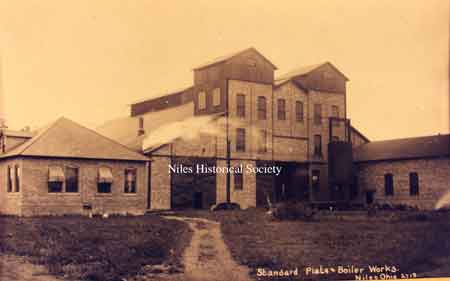
PO1.624
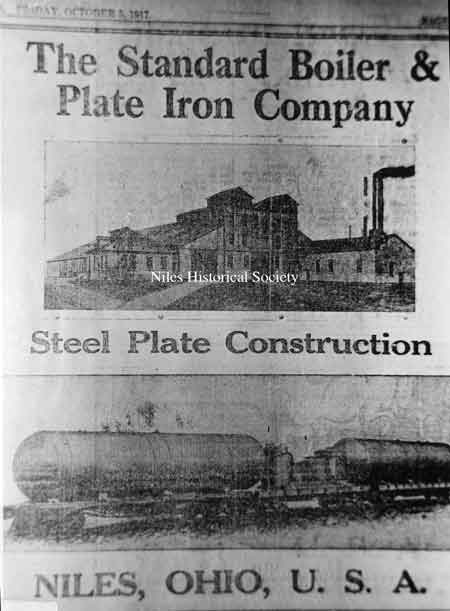
PO1. 623
An advertisement from the Niles
Daily News dated Oct. 5, 1917 for the Standard Boiler & Plate
Iron Co. located in Niles, Ohio
|
The Standard
Boiler and Plate Iron Company
The Standard Boiler and Plate Iron Company was
incorporated in 1906 by E. A. Gilbert, D. J. Finney and
associates.
In 1929, the controlling interest
was purchased by John Warne and E. J. Railly. The plant
stands west of the city near the Erie Railroad tracks.
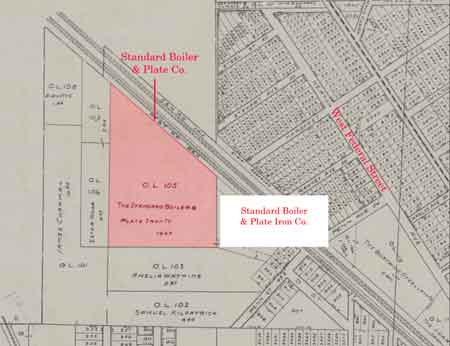
Location of the Standard Boiler & Plate Iron
Company on 1918 map.
|
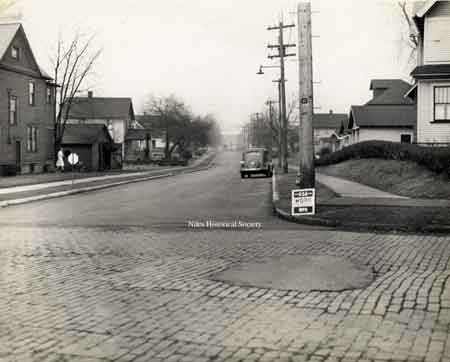
PO1.1678
A view from Emma Streeet looking
north from Warren Avenue when the WPA project was improving the
streets in Niles.
The building in the rear was
Standard Boiler Plate & Iron, which later became the Amweld
Building, Product Division. |
|
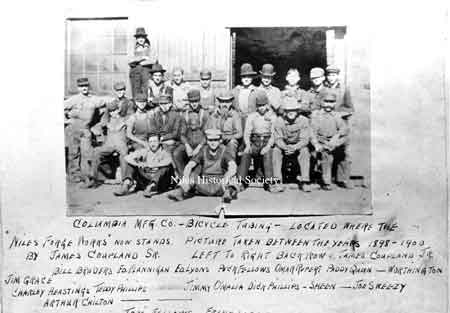
PO1.513
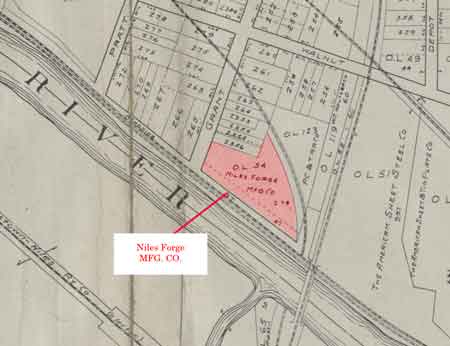
Location of Niles Forge and Manufacturing
Company on 1918 map. |
Niles Forge
and Manufacturing Company.
In 1909 the Niles Forge and Manufacturing Company was incorporated
with H. J. Robbins as president. George C. Campbell
as vice president. J.N. Baldwin as secretary and treasurer.
The Niles Forge plant was erected near the river
at the foot of Grant Street. In 1914 it was reorganized with C.
T. Sweeny, A. F. Sweeny and O. O. Hewitt as officers.
The structural steel used in the Niles Bank Company building was
fabricated here.
Columbia Manufacturing Co. -Bicycle tubing- located
where the Niles Forge stood until 1975.
Picture taken of the crew between 1898 and 1900
by James Coupland Sr.
L to R back to front: James Coupland Jr.,
Bill Bruders, Ed Flannigan, Ed Lyons, Peck Fellows, Omar Rupert,
Paddy Quinn, ? Worthington, Jim Grace, Charley Heastings, Teddy
Phillips, Jimmy O'Malia, Dick Phillips, ? Sheen, Joe Sweezy, Arthur
Chilton, ?,?, Tom Fellows, Frank Lafford.
|
|
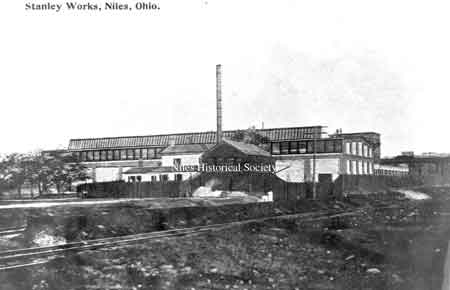
PO1.626
|
Stanley
Works
In 1910 the Stanley Works of New Britain, Connecticut, constructed
a branch plant in Niles at the south end of Carle Avenue. Mr.
R.M. Smith has been manager since establishment of the plant.
It manufactured nuts, bolts, washers and small
fittings. Operations were limited after WWII and the plant was
sold in the 1950's. In 1976, it was rented to Aluminum Billets,
Inc.
|
|
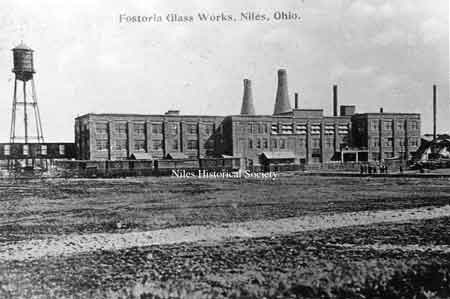
PO1.523
Constructed in 1910 by Fostoria Gass Co., many
of the first employees moved here from Fostoria, Ohio. Hand blown
glass bulbs were the initial products. Large circular kilns contained
molten glass in pots which was extracted through 16 curtain doors
on the end of five foot tubes by gatherers who handed the tube
to the blower. General Electric acquired the plant about 1911
and mechanized the process.
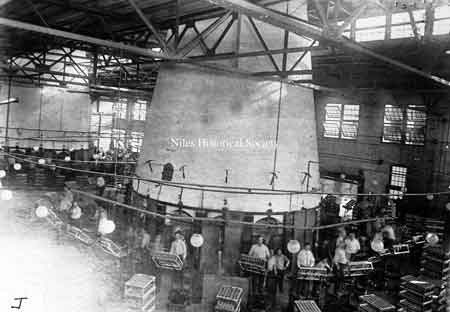
Photo of one of the glass furnaces and crew at
the Fostoria Glass Works, later GE. PO1.532 |
Niles
Glass Fostoria Works.
An important addition to local industries was the construction
in 1910 of the plant now occupied by the Niles Glass Works of
the General Electric Company. This plant recently has been giving
work to an average of 245 employees in the manufacture of electric
light bulbs. Mr. Z. C. Kline has been the superintendent
since 1924.
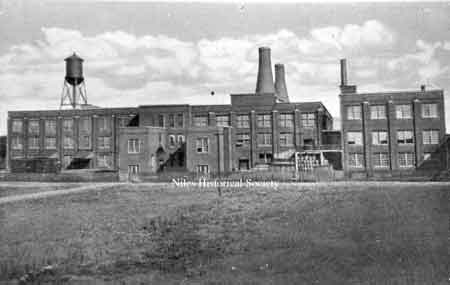
PO1.527
Another view of the Fostoria Glass Works built
in 1909 and taken over by GE in 1911. Located at the corner of
Main Street and Federal Street.
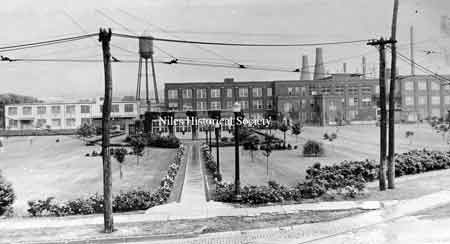
PO1.526a
The General Electric Plant and grounds. It was
built about 1909-1910 and merged with National Lamp & GE in
1911. Before mechanization in the early twenties, 205 blowers
blew about 225,000 bulbs per day. A blower and gatherer could
blow 1100 bulbs in an 8 hour day. After mechanization, 2 men and
a machine could make 3,000 to 5,000 bulbs per hour.
|
|
Niles Iron
and Steel Roofing Company
In 1911 the Niles Iron and Steel Roofing Company at 110 Erie Street,
originally formed by George Robbins in 1890, was reorganized
under the Deforest Sheet and Tin Plate Company.
In 1926 it was purchased by a new firm headed
by E.H. Hughes, R. G. Hughes and T. E. Pritchard,
the present owner. In normal times the firm employed twelve men
in the manufacturing of roofing equipment and furnace supplies.
The firm removed from Erie Street to the present Warren Avenue
site in 1928. |
|
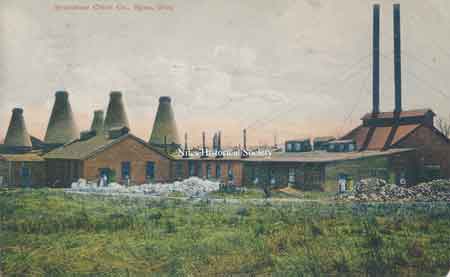
Bradshaw Pottery in 1901. It was
built on the P.Y. & A right of way and Hunter Street.
PO1.510
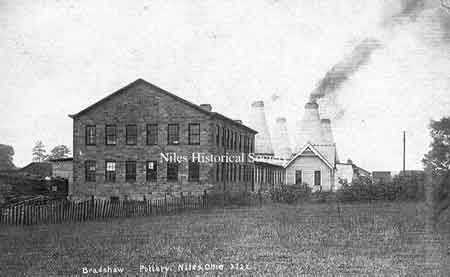
A photo of the Bradshaw Pottery
in Niles. in Roundstown. Construction began in April 1901. In
digging the foudation for the new pottery a big bed of clay
of the kind used in making red building brick was discovered.
PO1.509a
|
The Tritt
China Company
The Tritt China Company incorporated in 1912 and constructed a
pottery plant at Hunter Street and Warren Avenue. The pottery
was used by the Atlas China Company organized in 1922. In 1925
fire destroyed a large part of the plant but it was rebuilt and
operated for a time after 1926 by the Atlas Globe China Company.
Since the depression began the plant has been idle.
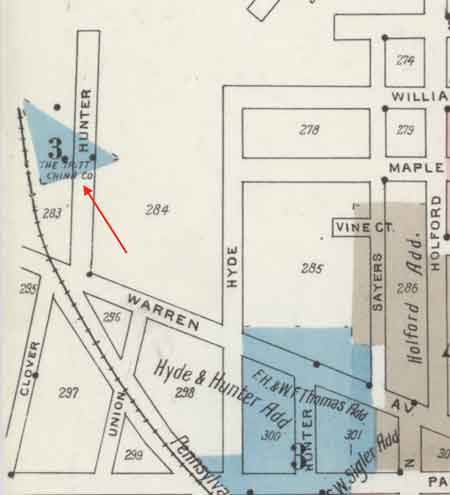
|
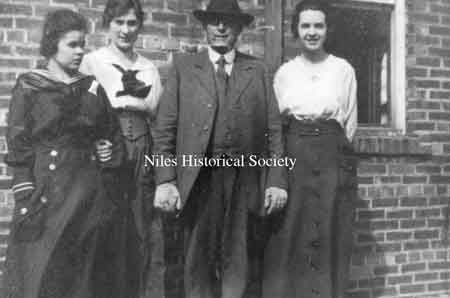
Picture of Mr. Tritt with several employees of
the Tritt China Factory, which occupied the orginal location of
Bradshaw Pottery.
The photo is dated October 1918. Alma Heeter,
Edith Stevens, W.E. Tritt, Adella Crumbaker. PO1.632
Map on the left shows the location of Tritt China
(also Bradshaw China and Atlas China Companies) on 1918 map. |
|
Thus in the ten years
from 1902 to 1912, at least twelve important industries had located
in Niles. Yet, as a whole it was a period of rather slow and cautious
growth, checked at the outset by the loss of the former iron industries
and later by the brief “money panic” of 1907.
During the decade 1900-1910, the population increased
but 12 percent, from 7468 to 8361, as compared with a 74 percent
increase in the preceding decade. |
|
| |
|
|


